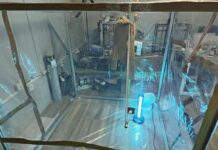
Black carbon (BC) – comprising airborne soot-like carbon particles – is gaining prominence on the radar of those concerned with air quality. Envirotec spoke to Acoem about the measurement challenges it presents, and how these are being addressed.
With its significant health and climate impacts, BC is a pollutant that would seem to be ripe for the appearance of legislation or at least clear WHO air quality guidelines to assist with curbing it. But it’s not quite that simple.
In contrast to many other pollutants, for which standardised measurement protocols are available, with numerical air quality guidelines issued by the WHO,1 BC measurement is not backed by this kind of detail, which would support the introduction of an enforceable limit. As Jost Lavric of Acoem Environment explains, the absence of standardisation may still stand in the way of implementing routine BC measurements on a large scale.
However, efforts to standardise the metrics used for BC measurement appear to be making progress. One prominent initiative is stanBC, a European project carrying the full title, “Standardisation of Black Carbon Aerosol metrics for air quality and climate modelling”, a group in which Acoem is a stakeholder.
BC is produced by the incomplete combustion of fossil fuels and biomass. It is estimated that, on average, household energy and transport are responsible for about 75% of the BC emissions globally, with the source proportions varying between different regions.2 BC is formally defined as an ideally light-absorbing substance composed of carbon,3 and optical methods have dominated approaches to measuring it. The designation generally applies to the smaller-sized fractions of particulate matter – between 0.5 µm and a few nanometres in diameter.
PM2.5 mass concentration, a well-established parameter in air quality monitoring regimes, is defined as particulate matter with an aerodynamic diameter of 2.5 µm or less. It will thus include an unknown of quantity of BC, which will also have the tendency to represent a significant part of the ultrafine particles fraction (UFP; smaller than 0.1 µm).
As BC’s distinct, negative impacts and provenance come into sharper focus, there will likely be greater impetus to monitor and regulate it separately. Its health effects are considered more insidious than the larger particle PM fractions, since the smaller the particles, the deeper they can penetrate the body – with the finest particles being able to infiltrate blood vessels and organs. In addition, BC is also recognised as a significant contributor to global warming.4
Origins story
BC measurements are often focused on establishing the provenance and age of particles. As Jost Lavric explains, the system under study is a very dynamic one. If you put the same particle in different environments, the materials that absorb to its surface will vary. Typical adherents include condensing rainwater, volatile organic compounds, salts, and other materials (metals deriving from certain combustion processes and so on). With these additions, the light absorption properties of a particle will change, an effect that means optical measurements can probe into its history.
“Every component in the system will influence how the particle absorbs light of different wavelengths,” says Lavric. There are several instrument types that can help uncovering such details, but they can often be large, expensive and difficult to use. Tape-based absorption photometers such as the Met One Instruments powered by Acoem’s BC1054 multi-wavelength black carbon analyser provide a convenient solution for reliable and autonomous real-time measurements of BC concentrations. They are based on measuring light transmittance across a filter media, where the particles accumulate, at ten different wavelengths between the UV and IR part of the spectrum.
With the BC1054, it is possible to characterize the properties of a particle very accurately, probing deep enough into its history to ascertain, for example, whether it was produced by a combustion process in one type of engine as opposed to another, says Lavric.
The instrument can be used in many settings but is aimed primarily at the scientific researcher. It can, says the product literature, be used to provide BC data with levels of accuracy and precision on a par with industry standard reference monitors, but at a fraction of the cost.
For applications, where an increased granularity of BC data or rapid and uncomplicated deployment are prioritised (e.g., for emergency responder situations, or roadside monitoring), Acoem’s BC 1060 & 1065 portable or rack-mounted, and the C-12 low-cost portable monitors are a good choice, says Lavric.
They are intended for users with less exacting requirements for depth of characterisation (compared to the BC1054), and offer a greater focus on portability and affordability. The BC 1060 and 1065 instruments measure the absorption of two wavelengths of light – 370 nm (UV) and 880 nm (IR) – and are suitable for determining the source of a BC particle (i.e., did it come from a wildfire or a car engine?), and providing a basic exploration of its origin. The same measuring technology is used in both, but the BC1060 comes in a weatherproof enclosure, while the 1065 is a rack-mounted system for installation in a laboratory or suitable enclosure.
The C-12 is described as a revolutionary device, packaged in a weatherproof and optionally solar powered compact enclosure. It can be deployed quickly to deliver remotely and autonomously high-quality data from urban or remote locations.
As Acoem’s Derrick Jepson explains, such instruments fit well within a larger picture of BC measurement. He underlines the importance of our developing knowledge on BC (and ultrafine particles in general) being backed by continuous technological and analytical advancements.
Whatever the instrument, the requisite backdrop of standards and calibration metrics is still evolving, making projects like stanBC a very important piece of the puzzle.
Notes
[1] WHO global air quality guidelines: particulate matter (PM2.5 and PM10), ozone, nitrogen dioxide, sulfur dioxide and carbon monoxide (2012) https://www.who.int/publications/i/item/9789240034228
[2] https://www.ccacoalition.org/short-lived-climate-pollutants/black-carbon
[3] https://stanbc.com/wp-content/uploads/2024/04/Ciupek_STANBC_EAC2023.pdf.
[4] https://www.ipcc.ch/report/ar6/wg1/downloads/report/IPCC_AR6_WGI_SPM_final.pdf






